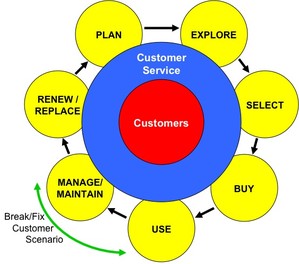How Customers Want to Get Their Products Fixed and Problems Resolved
Identifying and Measuring the Key Moments of Truth in "Break/Fix" Customer Scenario® Patterns
When something breaks, customers want it fixed! And, no matter the individual context, there is a common set of actions that customers want to happen: an explanation of what went wrong, a repair in a timely fashion, and reassurance it won’t break again. Learn more about this customer scenario pattern and how your company should measure whether you are satisfying their priorities/moments of truth. And recognize the, when you map out all your customers’ common scenarios, you have an actionable customer journey map that spans their entire relationships with your organization.
NETTING IT OUT
Customer Scenarios®--their ideal way to get things done--fall into patterns. Based on running hundreds of customer co-design sessions with thousands of customers, we’ve noticed that customers in a particular context tend to want the same things. It‘s valuable to know these patterns ahead of time so that you’ll know what kinds of customer metrics and operational metrics to elicit. Then you can focus your co-design activities on the real secret sauce: how to differentiate the experience, products, and services you offer to help customers reach their goals.
Your Customer’s Ideal Process
A customer scenario is a set of tasks that a particular group (segment) of customers is happy to do in order to accomplish their desired outcome(s).
In the typical “break/fix” scenario, it is practically universal that the customer has three key concerns:
- I don’t know what’s wrong
- I can’t get it fixed
- I don’t want it to happen again
We call these the customer’s “Moments of Truth”—aka “showstoppers”—if you don’t address these issues crisply, you risk losing your customer forever.
Once you recognize the common moments of truth, you can identify the types of customer metrics and operational metrics that measure how successful you are at meeting your customers’ ultimate goals for doing business with you. Then you can focus your co-design activities on how to differentiate the experience, products, and services you offer to help customers reach those goals.
Identifying the metrics allows you to recognize:
- How the customer will be “grading” you
- How you grade yourself in helping the customer be successful
- How you can identify and measure business opportunities that can result from providing a great customer experience
A TYPICAL “BREAK/FIX” CUSTOMER SCENARIO
The Customer Lifecycle
© 2014 Patricia Seybold Group Inc.
The customer lifecycle begins with customers looking for solutions and continues to their planning for the next product/service solution that they need, leading, again, to the exploration phase. Most customer scenarios span two or three of the phases. The break/fix customer scenario addressed in this report addresses the use and manage/maintain phases of the cycle. When you map all the scenarios in the entire customer lifecycle, you will have a customer journey map.
Similar for Products and Services, B2B and B2C
No matter what business you’re in, or what type of products or services you use, things break. Equipment doesn’t work, unexpected results show up, information isn’t received on time, billing goes awry, and on and on. Although there are uncountable variations on this theme, it all comes down to this: something is broken and I want it fixed!
Moments of Truth in Break/Fix
After facilitating hundreds of customer co-design sessions where there is a break/fix scenario, we can pretty much anticipate what moments of truth will emerge. Although there are always variations on a theme (based on specific customer type, specific service or product line, industry, and context), basically, there are three key moments of truth in every break/fix scenario...(more)
(Download the PDF to read the entire article.)
Sign in to download the full article
0 comments
Be the first one to comment.




